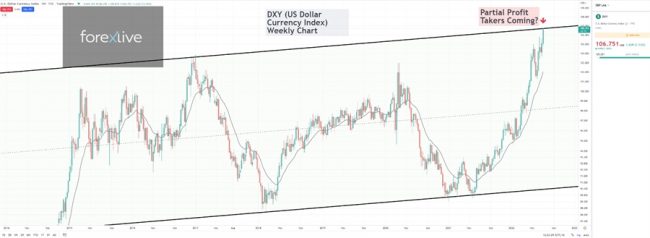- When profitable long traders, that have taken a previously successful Long on the US Dollar, are so profitable, following a major rally, what do they generally do?
- Many professionals at this situation need to mitigate their risk. One way of doing that is by lowering the size of their positions. That means taking partial or full profits, and perhaps entering again later
- These pros do not go out of their Long because they think, fundamentally, the US Dollar is weak, but because they must reduce their position’s risk, at least partially
- Algos are watching certain lines that others may be watching, and may be looking to sell, believing it is time others would sell
- The question is, also, if the lines are right and if the sell orders are strong enough, close to there, in addition to other factors
- In summary, do not be very surprised if the Dollar cools down soon, even temporarily, as the below shows
- This is not a trade idea, that is up to you. It is something to keep in mind for the US Dollar and Dollar index
Trade the US Dollar
US Dollar
The US dollar, (symbol $, code USD) is the fiat currency of the United States of America (USD) and the most widely traded currency globally. It was introduced into the US in the late 18th Century, with paper notes not being distributed until the following century. The US dollar, also informally known as the greenback, is the world’s most foremost reserve currency, due in large part to the importance of the US economy on the world stage. Once backed by gold (in the 1900’s), the USD is now a purely fiat currency, i.e. not backed by a physical commodity. The former gold standard aligned to the US dollar, made both gold and silver the legal-tender coinage of the USA, with the guarantee that 1 USD could be converted to one and a half grams of pure 24 carat gold. However, the gold link was eventually abolished by President Richard Nixon in 1971. Since the gold standard was cut, the US dollar has become the world’s number one reserve currency.This means foreign nations possess large amounts of their cash reserves in USD, accounting for approximately 65% of the world’s foreign exchange reserves.How to Trade the US Dollar?The US Dollar is traded in a variety of ways, most notably on the foreign exchange (forex) market versus other currencies; traded as pairs. Any retail broker offers exposure to the USD in many exchange pairs, given its popularity and liquidity. The USD is involved in the majority of the most traded forex pairs, such as the EUR/USD, the USD/JPY, the GBP/USD and the USD/CHF, known as the “four majors”, and the “commodity pairs”, i.e. AUD/USD, USD/CAD and the NZD/USD.
The US dollar, (symbol $, code USD) is the fiat currency of the United States of America (USD) and the most widely traded currency globally. It was introduced into the US in the late 18th Century, with paper notes not being distributed until the following century. The US dollar, also informally known as the greenback, is the world’s most foremost reserve currency, due in large part to the importance of the US economy on the world stage. Once backed by gold (in the 1900’s), the USD is now a purely fiat currency, i.e. not backed by a physical commodity. The former gold standard aligned to the US dollar, made both gold and silver the legal-tender coinage of the USA, with the guarantee that 1 USD could be converted to one and a half grams of pure 24 carat gold. However, the gold link was eventually abolished by President Richard Nixon in 1971. Since the gold standard was cut, the US dollar has become the world’s number one reserve currency.This means foreign nations possess large amounts of their cash reserves in USD, accounting for approximately 65% of the world’s foreign exchange reserves.How to Trade the US Dollar?The US Dollar is traded in a variety of ways, most notably on the foreign exchange (forex) market versus other currencies; traded as pairs. Any retail broker offers exposure to the USD in many exchange pairs, given its popularity and liquidity. The USD is involved in the majority of the most traded forex pairs, such as the EUR/USD, the USD/JPY, the GBP/USD and the USD/CHF, known as the “four majors”, and the “commodity pairs”, i.e. AUD/USD, USD/CAD and the NZD/USD.
Read this Term at your own risk.
www.forexlive.com
